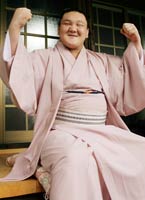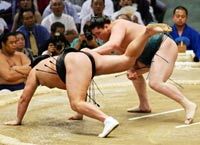|
|
|||||||
|
|
|||||||
|
|||||||
| | Web Japan >> | Trends in Japan >> | Sports >> | Grappling for the Top Spot | |
|
GRAPPLING FOR THE TOP SPOT Hakuho Eyes Promotion to Yokozuna (July 13, 2006) At the sumo tournament scheduled for July in Nagoya, ozeki (the second-highest rank) Hakuho is looking to do well enough to earn a promotion to yokozuna (highest rank). In the summer tournament in May, he set a record for an ozeki, winning 14 of his 15 bouts, and a promotion should be in his future if he repeats this feat in Nagoya. Some say that even if he wins 13 bouts, he could be promoted depending on the dominance of his performance. A promotion would mean Hakuho passing through the ozeki rank in just two tournaments, something that has never been done since the system of six annual tournaments was established in 1958. A Wrestling Family Becoming a yokozuna is quite possible for Hakuho. Asashoryu, the eastern yokozuna, is always well prepared and is a formidable wrestler, but Hakuho hopes to join him as the western yokozuna soon and then topple him as the number-one sumo star. Hakuho Sho's real name is Munkhbat Davaajargal, and he was born in Ulaanbaatar, Mongolia, on March 11, 1985. He first took part in a sumo tournament in Japan in March 2001, and he was promoted to the juryo division in January 2004. He made his way into the makuuchi division (the highest) in May that year. He immediately attracted attention for his strong yori (body push) and his powerful nage (throwing technique), and a number of observers referred to him as a "future yokozuna." He moved up through the ranks quickly. With Asashoryu out injured for most of the 2006 summer tournament, Hakuho dominated and walked away with the trophy. At the age of 21 years and 2 months, Hakuho became the fourth-youngest sumo wrestler ever to win a tournament after Takahanada (later known as Takanohana), Taiho, and Kitanoumi. Hakuho's father, Munkhbat, was a grand champion in Mongolian wrestling and a national hero. Hakuho, though, had practically no experience in Mongolian sumo when he was invited to Japan by former wrestler Kyokushuzan six years ago. As he is just 175 cm tall and weighed just 68 kg at the time, he had a difficult time trying to find a stable that would accept him. The day before he was to return to Mongolia, though, Kyokushuzan asked Miyagino, a sumo stable-master, to train him. Without having any idea who his father was, the master and the wrestlers in the stable soon grew to appreciate Hakuho's strength. Both his size and his rank grew quickly. A New Rival Appears Hakuho appears to be aware that he will be seeing a great deal of Baruto in the future. Asked which wrestler most concerns him, Hakuho answered "Baruto" without any hesitation. The sumo world at present features Mongolian wrestlers like Asashoryu and Eastern European wrestlers like Kotooshu. Most of them are still young, so their best days may yet be ahead of them. Copyright (c) 2006 Web Japan. Edited by Japan Echo Inc. based on domestic Japanese news sources. Articles presented here are offered for reference purposes and do not necessarily represent the policy or views of the Japanese Government. |
SUMO'S ANSWER TO BECKHAM (January 11, 2006) SUMO GOES INTERNATIONAL (February 4, 2004) |
|
|




